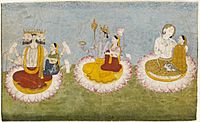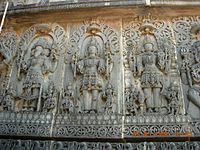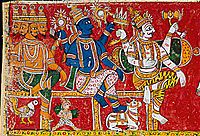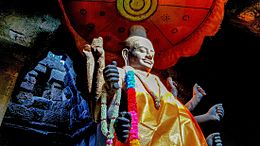Trimurti facts for kids
Quick facts for kids Trimurti |
|
|---|---|
| Supreme Trinity of the Universe The Gods of Creation, Preservation, and Destruction Para Brahman, the Supreme Being |
|
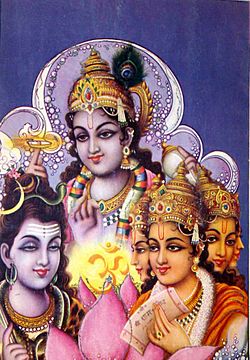
|
|
| Affiliation | |
| Abode |
|
| Mantra | Om Tridevaya Namah |
| Weapon |
|
| Mount | |
| Consort | Tridevi: |
| Translations of Trimurti |
|
|---|---|
| English | Trinity |
| Sanskrit | त्रिमूर्ति (Trimūrti) |
| Assamese | ত্ৰিমূৰ্তি (Trimūrti) |
| Bengali | ত্রিমূর্তি (Trimūrti) |
| Gujarati | ત્રિમૂર્તિ (Trimūrti) |
| Hindi | त्रिमूर्ति (Trimūrti) |
| Javanese | ꦠꦿꦶꦩꦸꦂꦠꦶ (Trimurti) |
| Kannada | ತ್ರಿಮೂರ್ತಿ (Trimūrtti) |
| Malayalam | ത്രിമൂർത്തികൾ (Trimūrttikaḷ) |
| Marathi | त्रिमूर्ती (Trimūrti) |
| Nepali | त्रिमूर्ति (Trimūrti) |
| Odia | ତ୍ରିମୂର୍ତ୍ତି (Trimūrtti) |
| Punjabi | ਤ੍ਰਿਮੂਰ੍ਤਿ (trīmūratī) |
| Tamil | மும்மூர்த்தி (Mum'mūrtti) |
| Telugu | త్రిమూర్తులు (Trimūrtulu) |
| Glossary of Hinduism terms | |
The Trimurti (meaning "three forms" or "trinity" in Sanskrit) are three very important gods in Hinduism. They represent the main jobs of the universe: creating, preserving, and destroying. These jobs are shown as three different gods.
Usually, the Trimurti are:
- Brahma, the creator of the universe.
- Vishnu, also known as Jagannath, who preserves and protects the universe.
- Shiva, who destroys the universe so it can be created again.
The sacred Om symbol in Hinduism is also linked to the Trimurti. The sounds "A," "U," and "M" in Om are thought to represent creation, preservation, and destruction. Together, they stand for Brahman, the ultimate reality. The Tridevi are the three goddesses who are the wives of the Trimurti gods.
Contents
The Idea of Trimurti
The idea of the Trimurti became very important in Hinduism between the 4th and 12th centuries CE. This time period is called the Puranic period. During this time, different groups within Hinduism, like those who mainly worshipped Shiva (Shaivism) or Vishnu (Vaishnavism), started to see their main god as the supreme one.
Even though these groups had their own favorite gods, there was also a feeling of harmony. The Trimurti idea helped bring them together. It showed that the supreme God could appear in three forms: Brahma, Vishnu, and Shiva. However, Brahma never became as widely worshipped as Shiva or Vishnu. Many groups saw the Trimurti as just three ways their own main god showed himself.
The Kūrma Purāṇa, an ancient Hindu text, strongly emphasizes that Brahma, Vishnu, and Shiva are all one being. This text explains that the three gods are different forms of the same supreme power. The Maitri Upanishad also talks about the Trimurti, describing them as three supreme forms of God.
Trimurti Temples
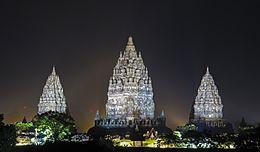
You can find temples dedicated to the Trimurti from as early as the 6th century CE. Some temples still actively worship the Trimurti today. These temples celebrate the three gods together.
Some famous Trimurti temples include:
- Baroli Trimurti Temple
- Elephanta Caves
- Mithrananthapuram Trimurti Temple
- Prambanan Trimurti Temple
- Savadi Trimurti Temple
- Thripaya Trimurti Temple
- Thirumoorthy hills
Different Views in Hinduism
The Trimurti concept is less central in modern Hinduism compared to ancient times. Different groups within Hinduism have their own ways of understanding the Trimurti.
Shaivism
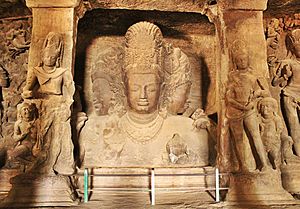
Followers of Shaivism believe that Shiva is the supreme God. They say Shiva performs five actions: creation, preservation, destruction, grace, and illusion. For Shaivites, Brahma, Vishnu, and Rudra (another name for Shiva) are not separate gods. Instead, they are different forms of Shiva himself.
- As Brahma, Shiva creates.
- As Vishnu, Shiva preserves.
- As Rudra, Shiva dissolves.
This means that Shiva is not just the "God of destruction." He is the supreme God who does everything. So, for Shaivites, the Trimurti is a way of seeing Shiva in three different roles. A great example of this is the Trimurti Sadashiva sculpture in the Elephanta Caves.
Followers of Vaishnavism mainly worship Vishnu as the supreme God. They generally do not focus on the Trimurti concept in the same way. Instead, they believe in the many different forms, or avataras, of Vishnu, like Narasimha, Rama, and Krishna.
Vaishnavites believe that Shiva and Brahma are also forms of Vishnu. For example, the Dvaita school of thought believes Vishnu is the only supreme God, and Shiva is less important. They interpret ancient texts differently to support this view. The Sri Vaishnavism tradition also believes that all major gods mentioned in ancient texts are actually forms of Vishnu.
Shaktism
Shaktism is a branch of Hinduism that focuses on the worship of the Divine Mother, or Supreme Goddess. In Shaktism, the important roles of creation, preservation, and destruction are given to goddesses, not male gods. This feminine version of the Trimurti is called the Tridevi ("three goddesses").
The Tridevi are:
- Mahasarasvati (the creator)
- Mahalaxmi (the preserver)
- Mahakali (the destroyer)
In this view, the male gods (Brahma, Vishnu, Shiva) are seen as helpers of the supreme Tridevi. The Srimad Devi Bhagwat Purana explains this. The Devi (Goddess) says she is the owner of the universe and the ultimate reality. She tells Brahma he will create, Vishnu he will preserve, and Shiva he will destroy and recreate. She says they get their power from her.
Smartism
Smartism is a Hindu group that worships a group of five deities, not just one. This system, called "worship of the five forms" (pañcāyatana pūjā), was made popular by the philosopher Adi Shankara in the 9th century. It involves worshipping five gods: Shiva, Vishnu, Brahma, Shakti (the Goddess), and Surya (the Sun god). Later, Kartikeya was sometimes added, making six.
Adi Shankara wanted to unite the main gods of different Hindu groups, giving them equal status. His philosophy taught that all these gods are different forms of the same ultimate reality, Brahman. This allowed people to choose one god as their main deity while still worshipping the others as different aspects of the same supreme being.
Saura
The Saura group worships Surya, the Sun god, as the supreme God. They do not accept the Trimurti in the same way. They believe Surya is God, and the other gods are manifestations of him.
Sometimes, earlier versions of the Trimurti included Surya instead of Brahma, Vishnu, or Shiva. Or, Surya was seen as a fourth god above the Trimurti, with the other three coming from him. For example, Surya was seen as Brahma in the morning, Vishnu in the afternoon, and Shiva in the evening. Some Sauras believe Vishnu, Brahma, or Shiva are forms of Surya, while others believe the Trimurti itself is a manifestation of Surya. Some Sauras worship only Surya.
See also
 In Spanish: Trimurti para niños
In Spanish: Trimurti para niños
- Dattatreya
- Om
- Tridevi
- Trinity
- Triple deities


